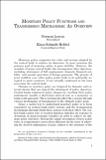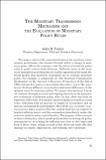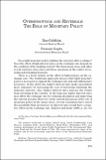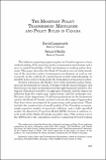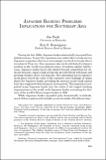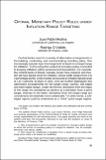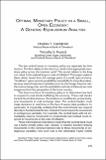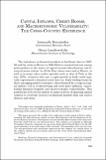Search
Now showing items 1-10 of 38
Policy rules and external shocks
The decade since 1990 has been a period of innovation in monetary policy. Around the world, many countries have adopted inflation targeting as their basic policy framework. Different countries have tried different techniques for achieving inflatio targets, such as different choices of policy instruments.
Monetary policy functions and transmission mechanisms: an overview
Monetary policy comprises the rules and actions adopted by the central bank to achieve its objectives. In most countries the primary goal of monetary policy is price stability. However, the mandate of many central banks also encompasses other objectives, including attainment of fullemployment, domestic ...
The monetary transmission mechanism and the evaluation of monetary policy rules
This paper explores the connection between the monetary transmission mechanism -the channel through which a change in monetary policy affects the economy- and the choice of monetary policy rules to guide central bank decisions. Differente views of the monetary transmission mechanism are readily apparent ...
Overshootings and reversals: the role of monetary policy
Does tight monetary policy stabilize the currency after a collapse?. Does the effect of high interest rates on the exchange rate depend on the condition of the banking system? The East Asian crises and other recent currency crises have put these questions at the center of economic policymaking decisions.
The monetary transmission mechanism in the United Kingdom: pass-through and policy rules
A number of recent papers have used policy simulations from small empirical macroeconomic models to assess the efficacy of inflation targeting or, more precisely, inflation forecast targeting (Svensson, 1997a). These include Rudebush and Svensson (1999). The models used to undertake these simulations ...
The monetary policy transmission mechanism and policy rules in Canada
The inflation targeting regime in place in Canada requires a clear understanding of the monetary policy transmission mechanism and a way to exploit knowledge of that mechanism in making policy decisions. This paper describes the Bank of Canada's current undestanding of the monetary policy transmission ...
Japanese banking problems: implications for Southeast Asia
During the late 1980s, Japanese banks substantially increased their global presence. In part the expansion was undertaken to help service Japanese companies that were increasingly involved in foreign direct investment. However, this expansion also can be attibuted to Japan's positio as the world's ...
Optimal monetary policy rules under inflation range targeting
Central banks resort to a variety of alternative arrangements in formulating, conducting, and communicating monetary policy. One increasingly popular type of arrangement is based on a target range for inflation. In this setup the conduct of monetary policy is oriented to keeping inflation withing ...
Optimal monetary policy in a small, open economy: a general-equilibrium analysis
The two central issues in monetary policy are separated by time horizon. The first relates to the short run: what is the appropriate monetary policy across the business cycle? The second relates to the long run: waht is the optimal long-run rate of inflation? This paper explores these classic issues ...
Capital inflows, credit booms, and macroeconomic vulnerability: the cross-country experience
The turbulence in financial markets is Southeast Asia in 1997-98 and the crisis in Mexico in 1994-95 have renewed interest among policymarkers in the issues of capital account liberalization and financial sector reform. In all the East Asian cases and in Mexico, as well as in many other earlier episodes ...


